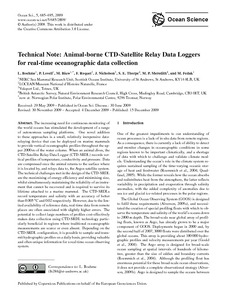| dc.contributor.author | Boehme, L. | |
| dc.contributor.author | Lovell, P. | |
| dc.contributor.author | Biuw, M. | |
| dc.contributor.author | Roquet, F. | |
| dc.contributor.author | Nicholson, J. | |
| dc.contributor.author | Thorpe, S. E. | |
| dc.contributor.author | Meredith, M. P. | |
| dc.contributor.author | Fedak, M. | |
| dc.date.accessioned | 2018-09-04T19:56:53Z | |
| dc.date.available | 2018-09-04T19:56:53Z | |
| dc.date.issued | 2009 | |
| dc.identifier.citation | Boehme, L.; Lovell, P.; Biuw, M.; Roquet, F.; Nicholson, J.; Thorpe, S.E.; Meredith, M.P. and Fedak, M. (2009) Technical Note: Animal-borne CTD-Satellite Relay Data Loggers for real-time oceanographic data collection. Ocean Sciences, 5, pp.685-695. DOI: http://dx.doi.org/10.25607/OBP-89 | en_US |
| dc.identifier.uri | http://hdl.handle.net/11329/507 | |
| dc.identifier.uri | http://dx.doi.org/10.25607/OBP-89 | |
| dc.description.abstract | The increasing need for continuous monitoring of
the world oceans has stimulated the development of a range
of autonomous sampling platforms.
One novel addition
to these approaches is a small, relatively inexpensive data-
relaying device that can be deployed on marine mammals
to provide vertical oceanographic profiles throughout the up-
per 2000 m of the water column. When an animal dives, the
CTD-Satellite Relay Data Logger (CTD-SRDL) records ver-
tical profiles of temperature, conductivity and pressure. Data
are compressed once the animal returns to the surface where
it is located by, and relays data to, the Argos satellite system.
The technical challenges met in the design of the CTD-SRDL
are the maximising of energy efficiency and minimising size,
whilst simultaneously maintaining the reliability of an instru-
ment that cannot be recovered and is required to survive its
lifetime attached to a marine mammal. The CTD-SRDLs
record temperature and salinity with an accuracy of better
than 0.005
◦
C and 0.02 respectively. However, due to the lim-
ited availability of reference data, real-time data from remote
places are often associated with slightly higher errors. The
potential to collect large numbers of profiles cost-effectively
makes data collection using CTD-SRDL technology partic-
ularly beneficial in regions where traditional oceanographic
measurements are scarce or even absent. Depending on the
CTD-SRDL configuration, it is possible to sample and trans-
mit hydrographic profiles on a daily basis, providing valuable
and often unique information for a real-time ocean observing
system. | en_US |
| dc.language.iso | en | en_US |
| dc.rights | Attribution 3.0 | * |
| dc.rights.uri | http://creativecommons.org/licenses/by/3.0/igo/ | * |
| dc.subject.other | Animal borne sensors | en_US |
| dc.subject.other | CTD-Satellite Relay Data Logger | |
| dc.subject.other | CTD-Satellite Relay Data Logger | |
| dc.subject.other | Animal borne sensors | |
| dc.subject.other | Marine mammals | |
| dc.subject.other | Argos satellite system | |
| dc.title | Technical Note: Animal-borne CTD-Satellite Relay Data Loggers for real-time oceanographic data collection. | en_US |
| dc.type | Journal Contribution | en_US |
| dc.description.refereed | Refereed | en_US |
| dc.format.pagerange | pp.685– 695 | en_US |
| dc.subject.parameterDiscipline | Parameter Discipline::Physical oceanography::Water column temperature and salinity | en_US |
| dc.subject.instrumentType | Instrument Type Vocabulary::CTD | en_US |
| dc.subject.dmProcesses | Data Management Practices::Data acquisition | en_US |
| dc.bibliographicCitation.title | Ocean Science | en_US |
| dc.bibliographicCitation.volume | 5 | en_US |
| dc.description.eov | Subsurface temperature | en_US |
| dc.description.eov | Subsurface salinity | en_US |
| dc.description.bptype | Manual | en_US |
| dc.description.bptype | Guide | en_US |
| obps.contact.contactname | L. Boehme | |
| obps.contact.contactemail | lb284@st-andrews.ac.uk | |
| obps.resourceurl.publisher | www.ocean-sci.net/5/685/2009/ | en_US |
 Repository of community practices in Ocean Research, Applications and Data/Information Management
Repository of community practices in Ocean Research, Applications and Data/Information Management

